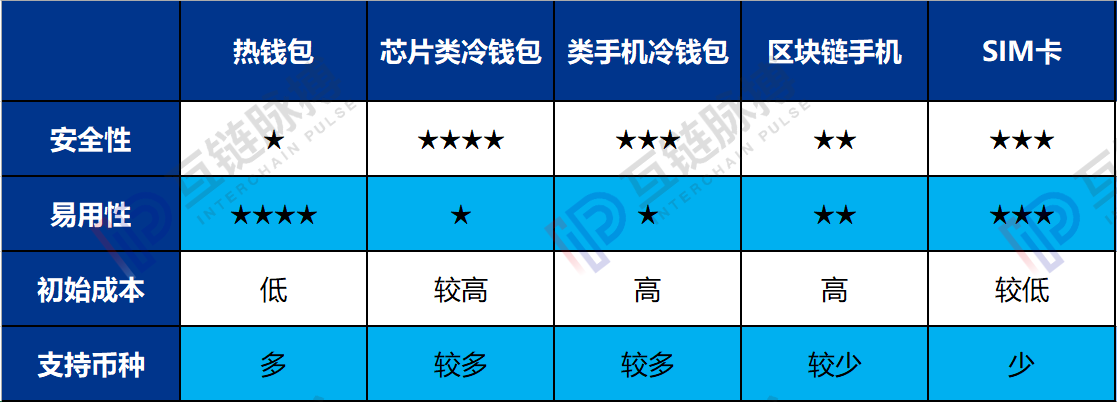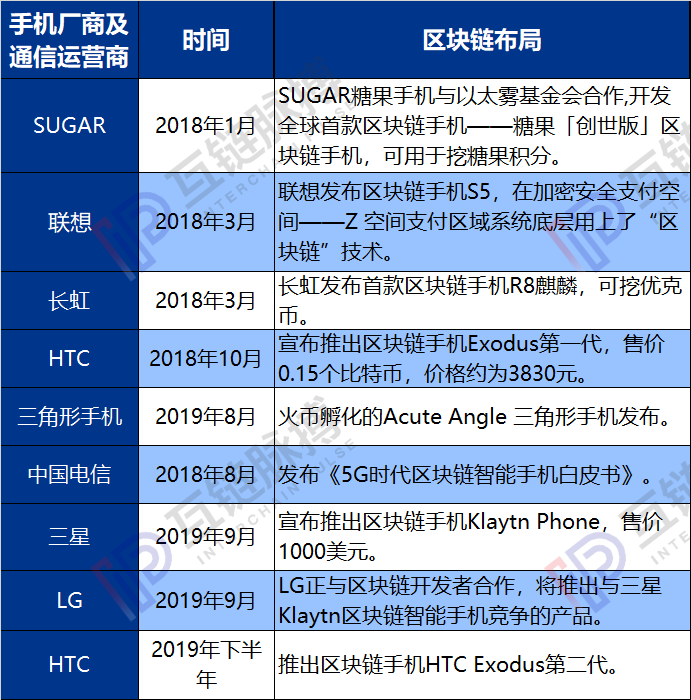China Telecom SIM card to kill cold, hot wallet, blockchain mobile phone still has no fire to cool?
Digital asset cold, hot wallets, and blockchain phones that are in the midst of the stagnation are welcoming strong competitors.
At the recent Chongqing Zhibo Conference, China Telecom released the "5G era blockchain smartphone white paper" (hereinafter referred to as "white paper"), and announced that it is developing a blockchain digital asset management system based on mobile phone SIM card.
This move will be a fatal blow to the cold and hot wallets in the current blockchain system.
Because the China Telecom SIM card carrying the blockchain digital asset management not only solves the drawbacks of the poor security of the hot wallet, but also makes the problem of low ease of use and cumbersome operation of the cold wallet completely overcome, and because the SIM card can adapt to any The manufacturer's mobile phone terminal, which makes the blockchain mobile phone currently in its midst may be cool.
- How to value a PoS project? "Three pool model" to understand
- Ethereum 2.0 development progress exceeded expectations, test network released soon
- What is bitcoin fork? Can you profit from the fork?
The digital wallet space is welcoming an emerging revolution, with hot wallets, cold wallets and blockchain phones likely to soon step down the historical stage of the blockchain.

(2019 Chongqing Zhibo Fair China Telecom announced the SIM card-based digital asset wallet DEMO)
Blockchain mobile phone, SIM card VS cold, hot wallet, who is more reliable?
At present, blockchain-based digital asset management is mainly based on hot wallets and cold wallets, but hot wallets often have hacking and stealing money due to low security. Although the security of the cold wallet has been improved, it is inconvenient to carry and the transaction is cumbersome. , ease of use is greatly reduced. The blockchain mobile phone takes the longest of both, and finding a balance between security and ease of use seems to be a viable solution.
At present, blockchain mobile phones have two directions for blockchain digital asset management solutions: one is to build a digital asset hard wallet inside the mobile phone body to store private keys and manage digital assets, mainly in Finney, Samsung Klaytn Phone, HTC Exodus, etc.; the other is to develop a digital asset management system based on mobile phone SIM card, which can be docked to any mobile phone terminal of any manufacturer, mainly by China Telecom, one of the three major communication operators in China. the Lord.
In order to better analyze the comprehensive performance of hot wallet, cold wallet, blockchain mobile phone and SIM card for digital asset management, the interchain pulse has four dimensions: security, ease of use, initial cost and number of supported currencies. A comparative analysis was conducted.

Security: Cold Wallet>SIM Card ≥ Blockchain Phone>Hot Wallet
From the perspective of security, the cold wallet has the highest security factor because it stores the private key in the mobile device, is isolated from the Internet, and is plug and play. However, there are two major categories of cold wallets on the market: one is a chip-based cold wallet represented by the Legender Nano S, Trezor, and KeepKey. The wallet will not be lost even if the user loses or the device is stolen by the hacker. It can protect the user's asset security; the other is an Android-based wallet represented by Kushen, Bepal, etc., also known as a mobile phone wallet. The focus of this kind of cold wallet protection is that the hot and cold end is isolated during the transaction. The transaction is secure when the device is not lost and is not targeted for targeted attacks.
Blockchain mobile phone and SIM card solutions, although built-in encryption hardware, combines the digital wallet function, but because mobile devices need to be networked in real time, hackers still have the opportunity to launch attacks, so the security still needs to be verified. However, since the SIM card needs real-name verification, it can be applied for loss reporting and recovery at any time after the loss, and its security is slightly higher than that of the blockchain mobile phone.
The hot wallet is stored on the network platform because of the private key. The risk of being hacked and stolen by the hacker is high. There have been too many hot wallet bitcoin theft incidents, so the security is the worst.
Ease of use: hot wallet>SIM card>blockchain mobile phone>cold wallet
From the point of view of ease of use, since most of the hot wallets have been put on the Android or IOS mobile phone application market, the downloading and use is convenient, and currently should be the most extensive, so the hot wallet is the most easy to use.
The ease of use of the SIM card is second only to the hot wallet. According to the white paper solution released by China Telecom, the SIM card based on the blockchain digital asset management system can connect to any manufacturer's mobile phone terminal. It can not only manage the digital asset wallet, but also the digital asset trading platform, which integrates a card multi-function. Therefore, the ease of use is also quite high.
The ease of use of blockchain phones is weaker than SIM cards. Although the blockchain mobile phone management digital wallet is equally convenient, users need to change the mobile phone in order to use the digital wallet, which increases the cost of use and is not cost-effective.
The cold wallet has the worst ease of use, which not only requires additional cost of use, but is also inconvenient to carry and the transaction process is cumbersome.
Initial Cost: Hot Wallet > SIM Card > Cold Wallet > Blockchain Phone
From the perspective of cost performance, the hot wallet download registration can be used without any hard cost, so the initial cost is the lowest. The SIM card only needs the user to change the mobile phone card to the business hall, and the initial cost is relatively low.
The initial cost of a cold wallet is relatively high, especially for cell phone cold wallets. For example, the Kushen wallet Pro3 and Pro 2 Plus currently on sale at Kushen official website are priced at 4,288 yuan, while the market price of the Bepal Pro S cold wallet is as high as 3,280 yuan.
Blockchain phones have the highest initial cost. For example, HTC released the blockchain mobile phone Exodus 1S in October last year, which is priced at 699 US dollars (about 4,974 yuan), while the blockchain mobile phone Finney developed by Sinrin Labs and the Klaytn Phone mobile phone launched by Samsung are respectively sold up. $999 and $1,000.

Support for digital asset types: Hot Wallet > Cold Wallet > SIM Card ≥ Blockchain Phone
From the perspective of supporting digital asset types, the number of hot wallets supported is undoubtedly the most. For example, the Jaxx hot wallet supports more than 50 digital assets, and Imtoken supports Bitcoin, Ethereum, EOS and all digital assets distributed on Ethereum, EOS, and even NFT collections.
The cold wallet is second to none. For example, Kushen Wallet can support 18 mainstream cryptocurrencies including BTC, ETH, XRP, EOS, etc. and all Ethereum ERC20-TOKEN.
SIM cards and blockchain phones are currently in the process of research and development or trial, and currently support relatively few types of digital assets. For example, China Telecom's SIM card-based blockchain digital asset management system will support Ethereum and ERC20 blockchain digital assets, while HTC Exodus 1S and Finney handsets currently only support the management of three digital assets.
Therefore, on the premise that security can be solved and guaranteed, blockchain mobile phone and SIM card solutions will be promising in the future blockchain world, especially China Telecom's SIM based on blockchain digital asset management system. The card is the traffic portal and the digital asset trading platform. Once the solution is mature and widely launched, it is likely to replace most of the current cold and hot wallets on the market, and even the blockchain mobile phone that has not yet been popular. .
The battle for the entrance control of the blockchain world
In fact, behind the traditional mobile phone manufacturers and communications operators to develop blockchain digital wallets, is a battle for entry control from the physical world to the blockchain world.
Earlier, blockchain phones used to be the main mining function. For example, the R8 Kirin mobile phone released by Changhong last year can be used to dig the Eucalyptus, the Ethereal Candy blockchain mobile phone for digging candy points, and the triangular mobile phone of the fire money capital investment for digging the NODE eco-coin.
After the concept of "mobile mining" was short-lived, traditional mobile phone manufacturers began to look at digital wallets. There are three reasons: First, the field is close enough to the transaction; second, the user group in this field is relatively large; finally, a number of application scenarios can be extended around this field.
The proximity to trading means that digital wallets are more than just a tool, but a capital entry and financial services platform. The large user base means that the digital wallet is a huge traffic portal. According to the incomplete statistics of Big Data Security's “Knowing Chuangyu”, the peak of Chinese digital currency buyers is about 3 million, but the number of Chinese stock investors has reached 142 million. With the rapid spread of digital currency in the future, The flow of digital wallet traffic can be imagined.
In fact, with the arrival of more blockchain projects and the era of 5G in the future, the functional attributes of the certificate will become stronger and stronger, and the digital wallet will release the functional potential of the certificate beyond the transaction.
For example, in the white paper published by China Telecom, the application scenarios of blockchain mobile phones include digital identity wallets, digital identity authentication, financial credit application, supply chain traceability applications, judicial applications, and express delivery applications.
For traditional mobile phone manufacturers and communication operators, the development of digital wallet is only the first step to seize the world of blockchain. In the future, with the increasing demand for digital asset identification, transactions, digital identity authentication, more mobile phones. Vendors, communications carriers or camps that will join.

Text | Mutual Chain Pulse · Liang Shan Hua Rong
This article is [inter-chain pulse] original, reproduced please indicate the source!
We will continue to update Blocking; if you have any questions or suggestions, please contact us!
Was this article helpful?
93 out of 132 found this helpful
Related articles
- The difficulty of mining is implied: Bitcoin will reach $31,000 in 2021.
- Compliance, endorsement path: inventory cryptocurrency exchange registration holy place
- The world's most "calculating" companies are vying to lay out the blockchain, the transformation of the four major accounting firms such as PricewaterhouseCoopers.
- Technical Teaching | Solidity Programming Language: Address
- Proof of validity and proof of error in Science-2 |
- Economist Ba Shusong: The Application Value of Blockchain Technology in the Financial Field
- The volume is falling, is it a dishwashing or a shipment?






